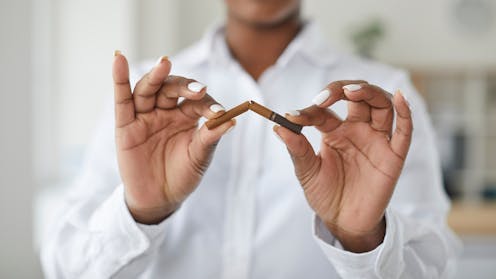New funds will tackle Indigenous smoking. But here's what else we know works for quit campaigns

Among all the talk this week about a crackdown on vaping – the most significant tobacco control reforms in a decade – has been the roll-out of another major document.
The National Tobacco Strategy 2023–2030 was launched this week.
A key priority of the strategy is Aboriginal and Torres Strait Islander smoking and Closing the Gap. We heard the Tackling Indigenous Smoking program would be extended and widened – with A$141 million funding – to reduce both vaping and smoking among Aboriginal and Torres Strait Islander people.
Here’s why that’s urgently needed and what needs to happen next to reduce smoking rates among Aboriginal and Torres Strait Islander people.
Read more: We can cut Indigenous smoking and save lives – here's how
Tobacco is still a killer
Tobacco legally kills over 57 Australians a day. That’s equivalent to extinguishing an entire country town of 21,000 every year.
It’s still the single biggest preventable risk factor for disease and premature death. For Aboriginal and Torres Strait Islander people, more than a third of all deaths are caused by tobacco. Over the past decade we have lost more than 10,000 Aboriginal and Torres Strait Islander lives due to smoking.
Multiple policy failures beyond health – from poverty, education, employment, housing, family removals, dislocation and the systematic embedding of tobacco as rations in lieu of wages – mean Aboriginal and Torres Strait Islander people are disproportionately impacted by the harms of Big Tobacco.
So the funding to expand the Tackling Indigenous Smoking program is urgently needed to have no more than 27% of Aboriginal and Torres Strait Islander smoking by 2030 (5% of all Australians).
There have been huge achievements in reducing Aboriginal and Torres Strait Islander smoking. In 2018–19, 40% of Aboriginal and Torres Strait Islander adults smoked daily, down from 50% in 2004–05. A target of 27% is achievable. But to get there we need something “extra” to accelerate those reductions.
Read more: Here's how to close the gap on Indigenous women smoking during pregnancy
We know what works
Tobacco campaigns are one of the most cost-effective interventions when evidence-based, market-tested, sustained and with support services at the end of the call to action. When they are adequately funded, they can impact inequities.
Campaigns must be personally relevant and meaningful to be effective. This makes the case for targeted approaches, including local level campaigns, reinforced by general, national activity. Audiences engage with the message when they can see themselves and their community members (sometimes actually) in the advertising.
We saw this nationally with Break the Chain starring Aboriginal actor and comedian Elaine Crombie. Originally this was a targeted campaign for Aboriginal and Torres Strait Islander people. But it then aired nationally targeting all Australians in 2014.
The ‘Break the Chain’ campaign featured Aboriginal actor and comedian Elaine Crombie.Don’t Make Smokes Your Story was launched in 2016, as part of the Tackling Indigenous Smoking program. This was created by Indigenous agency Carbon Media, starring musician Fred Leone alongside real stories from community members.
‘Don’t Make Smokes Your Story’ campaign.One of the most successful and innovative Aboriginal and Torres Strait Islander tobacco campaigns, it included a toolkit for Aboriginal and Torres Strait Islander communities to use and adapt the national campaign to their local contexts.
An excellent example of this is from the Apunipima Tackling Indigenous Smoking team with its local campaign Don’t Make Smokes Your Story Cape York.
Campaigns can be localised, like this one from Cape York.When Aboriginal and Torres Strait Islander people lead and promote smoke-free behaviours, communities are more interested in quitting.
What works? Product, price, place and promotion
Social marketing campaigns, like the ones we’ve mentioned, really work well when they take on the Four Ps of product, price, place and promotion.
The beautifully produced ads, the “promotion”, can’t have impact on their own. This is where the rest of the National Tobacco Strategy comes in.
1. Product
We’ve reduced product appeal with plain packaging and graphic health warnings. This will be enhanced with new warnings, including on the sticks themselves, plus greater uniformity of standardised packaging and tightened rules around additives and flavours that make smoking palatable.
2. Price
Price increases reduce smoking and we’ll see a tax increase of 5% each year for three years across all different tobacco product types.
3. Place
We have known about the harms of commercial tobacco since at least 1950. Yet we still expect individuals to give up nicotine instead of removing this lethal product from sale at pretty much every supermarket, service station and convenience store.
The National Tobacco Strategy is considering a national licensing scheme, removing online sales and delivery services, and potential for reducing the number, type and location of tobacco outlets.
There will also be more action on smoke-free areas and making sure all health professionals (particularly in remote places) are equipped to support quit attempts.
The strategy states it will explore raising the age you can buy cigarettes and monitor how this works overseas.
4. Promotion
The commitment to close any last promotional loopholes for tobacco and e-cigarettes, particularly online is also important, along with local and national anti-smoking campaigns. But we know these are not enough on their own.
What we also need
Addressing all four Ps is what comprehensive tobacco social marketing would look like. It’s what’s required to accelerate the declines to get to the 27% target for Aboriginal and Torres Strait Islander peoples, and 5% nationally.
Targeted approaches are critical and can be effective, but they need to be supported by bigger, whole of population structural changes. The community-led campaigns, supported by national activity, will reinforce and amplify the policy changes that will come through on the tobacco product, its cost and its availability.
That’s how we realise our goals and ultimately eliminate tobacco related disease and death.
Authors: Christina Heris, Research Fellow, Australian National University




